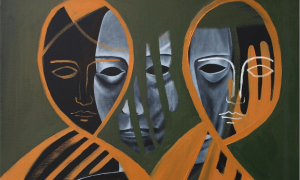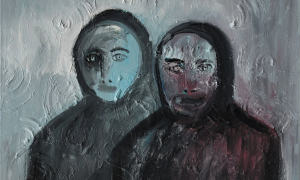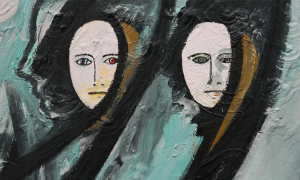Home » Jazz Articles » Jazz in Long Form » The Vocal Music of Charles Mingus
The Vocal Music of Charles Mingus

In my music, I’m trying to play the truth of what I am. The reason it’s difficult is because I’m changing all the time.
Part I
Charles Mingus is not typically the first name that comes to mind when discussing jazz vocal repertoire, but perhaps it should be. Since the 1940s, Mingus wrote songs in collaboration with other musicians and even penned his own lyrics. His oeuvre encompasses popular songs of the era as well as intricate vocal compositions that rival those of his self-proclaimed mentor, Duke Ellington. Despite their artistic merit, only a few of these pieces have gained widespread recognition among jazz aficionados and vocalists. Having been aware of these finely crafted songs as a vocalist and educator for over four decades it is perplexing why these vocal gems are still not as widely performed.Saxophonist Charles McPherson, a former member of the Mingus band, disclosed that Mingus had quite a passion for writing poetry. Mingus' love for poetry was a significant aspect of his creative output and his lyrical prowess is yet another testament to his multifaceted talents. His collaborations with poets and writers show his willingness to explore and experiment with different artistic forms and mediums. It has been noted that he enlisted Allen Ginsberg to perform at his wedding ceremony with Sue Mingus, performed with the beat poet Kenneth Patchen, and wrote pieces of music to accompany the texts of Frank O'Hara and D.H. Lawrence. Mingus' collaboration with songwriter and poet Joni Mitchell is not only a testament to his love of words and poetry but perhaps a deliberate statement at the time of his passing.
Mingus' vocal compositions, featuring his original lyrics, and his collaborations with Mitchell and others have certainly left us with a rich vocal music legacy. Although Mingus wrote popular songs early in his career, the vocal compositions that are currently most recognized include "Duke Ellington's "Sound of Love," "Weird Nightmare," "Eclipse," "Portrait," "Dry Cleaner From Des Moines," and "Goodbye Porkpie Hat," with the last two from Mitchell's Mingus (Asylum, 1979) album project. Following Mingus' passing, Sue Mingus allowed a few other lyricists to contribute to the Mingus repertoire, some of which were recorded by various artists. Some notable compositions (with lyrics contributed by the author and Elvis Costello) include "Nostalgia In Times Square," "Noddin Ya Head Blues," "Peggy's Blue Skylight," "Slippers," "Orange Was the Color of her Dress, Then Blue Silk," "Don't Be Afraid, The Clown's Afraid Too," "Hora Decubitus," "Invisible Lady," "Jelly Roll," "Self-Portrait In Three Colors," and "This Subdues My Passion."
Famous Farewell
"Goodbye Porkpie Hat," one of Mingus' most famous vocal compositions, was originally written as an instrumental bass improvisation to honor tenor saxophonist Lester Young. The composition juxtaposes a mutant blues motif with a chord progression that diverges markedly from traditional blues convention. The introductory chords exhibit an extensive use of 9ths and 13ths, contributing to a lush tonal palette. In the ensuing solo sections, each chord is constructed as a 7th or minor 7th, resulting in a remarkable level of harmonic complexity. During the 1970s, multi-instrumentalist Rahsaan Roland Kirk recorded his own set of lyrics that became popular among jazz vocalists of that era on The Return of the 5000 Lb. Man (Warner Records, 1976). Although the current generation of jazz singers seems more familiar with the Mitchell version there are many instrumentalists and singers that continue to perform the Kirk version of the song. The lyrics (found below) are a deeply moving personal eulogy to Young's influence on Kirk and his love of the tenor saxophone, lyrical phrasing, and the Bebop era. Some notable performers of the Kirk version include Sheila Jordan, Mark Murphy, Jeanne Lee, Karrin Allyson, Frank Lacy, and Kevin Mahogany.He put all of his soul
Into a tenor saxophone
He had his way a talking
T was a language of his own
Life story love and glory
If you listen when he plays it for you
Now listen and listen, and dig it-
Can you dig it?
Lester Young is playing what he's feeling
Dealing and dancing...
Now someone might have told you
Lester Young, he's out of style
But now I'm here to tell you
Prez is happening right now
Life's story, love, and glory
If you listen when he plays it for you
Now listen and listen and dig it,
Can you dig it?
Lester Young is playing what he's feeling
Dealing and dancing you home.
The Mitchell version is based on the tenor sax solo by John Handy from the recording Mingus Ah Um (Columbia Records, 1959). This interpretation recounts the challenges that Young faced in both his musical and personal life, offering insight into his struggles and triumphs. Mitchell herself experienced difficulty in crafting the final verse of the song, until she had what she referred to as a "magical experience" while in New York, which ultimately helped her to complete the composition.
Final verse:
We came up from the subway,
On the music midnight makes.
To Charlie's bass and Lester's saxophone in taxi horns and brakes
Now Charlie's down in Mexico with the healers
So, the sidewalk leads us with music
To two little dancers
Dancing outside a black bar
There's a sign up on the awning
It says, "Pork Pie Hat Bar"
And there's black babies dancing tonight.
According to musician Dave Blackburn who offers a transcribed version on the Mitchell website, "The band substitutes and reharmonizes a lot so each verse Joni sings has different chords behind it. Mingus was known for using a lot of dominant chords in his writing, especially altered dominants and this was the prevalent harmonic language in the late 50's and early 60's New York jazz." (The complete transcription of the lyrics is found at Mitchell's website.)
Both Poet and Social Justice Advocate
Mingus believed that music and poetry were deeply intertwined and that lyrics could enhance the emotional impact of a song. However, Mingus' artistry went beyond just creating beautiful lyrics. He also saw himself as an activist, using his compositions to communicate an agenda of resistance and protest through allegories that resonated with his audiences. In his music, he used musical statements and outspoken critiques to convey his message, often complemented by his own lyrics and poetry. "Duke Ellington's Sound of Love" and "Eclipse" are examples of compositions where his lyrics take center stage, adding depth and nuance to his already masterful musical creations. "Eclipse," for example, delves into the subject of racism and interracial marriage, a topic that was not only controversial but personal to Mingus himself. The lyrics of "Duke Ellington's Sound of Love" pay homage to one of his greatest influences while highlighting a spiritual connection beyond their music. Each composition stands as a testament to Mingus' unparalleled ability to combine melody, harmony, and poetry into a single, cohesive work of art.Eclipse as a Metaphor
Mingus expressed his experiences with racism as a black man and musician through his music, and "Eclipse" is a poignant example. According to the book Mingus More Than A Fake Book, he sent the sheet music to Billie Holiday, hoping she would perform it, as he believed she could convey the message just as she did with "Strange Fruit." Mingus also approached Sheila Jordan, who was in a biracial marriage with Charlie Parker's pianist, Duke Jordan, but she was not available for the recording session. The composition was eventually recorded by Lorraine Cusson in 1960 for the album Pre-Bird (Mercury, 1961) and later re-released on the recording Mingus Revisited (Limelight, 1965).Eclipse, when the moon meets the sun,
Eclipse these bodies become as one.
People go around, eyes look up and frown,
For it's a sight they seldom see.
Some look through smoked glasses hiding their eyes,
Others think it's tragic, sneering as dark meets light.
But the sun doesn't care, and the moon has no fear,
For destiny's making her choice.
Eclipse, when the moon meets the sun,
Eclipse these bodies become as one.
Indeed, the image of an eclipse is a powerful metaphor for black and white relationships, and Mingus skillfully uses it to express the beauty and complexity of these connections. By juxtaposing the sun and the moon, which are typically seen as opposites, Mingus highlights the deep connection that can exist between seemingly different entities. Despite being opposites, these celestial bodies become one, representing a powerful union. At the same time Mingus also acknowledges the societal disapproval stemming from racism that acted as an obstacle to pursuing such relationships. By doing so, he confronts the societal prejudices head-on using his music to challenge the status quo by shedding his own musical light on equality and understanding.
The form of "Eclipse" is asymmetrical and can be viewed as either two sections of 13 bars and then 8 bars or, from a lyrical point of view (similar to an ABA form), 4 bars, 13 bars and returning to a repeated 4 bars. Mingus' innovative use of dissonant notes, like the E natural on a Db chord at the beginning and ending of the first lyrics, contributes to the haunting quality of the melody. As the lyrics become judgmental, portraying disapproval and intolerance, the melody and harmony become more discordant with larger intervals that eventually resolve on the word "light."
Nevertheless, the song's lyrics suggest that despite the chaos and negativity, destiny is at work unifying the two celestial bodies. When the phrase "destiny's making her choice" is delivered, the song lifts to its highest note, emphasizing the spiritual and universal connection between people. The compelling lyrics of Mingus, coupled with intricate melody and harmony, elevate the composition's artistic quality to that of a classical art song.
Sound of Love
Inspired by Ellington, Mingus pays tribute not only in his lyrics but with a nod to compositions like "Lush Life" and "The Star-Crossed Lovers" in his composition "Duke Ellington's Sound of Love." This song was sung by George Adams on Changes One(Atlantic, 1974) and later by Jackie Paris on Changes Two (Atlantic, 1975). This musical composition exhibits a distinctive trait in its implementation of upper structure extensions, showcasing Mingus' adept manipulation of altered 9, 11, and 13 chords within the melody. This hallmark sound of Mingus' compositions retains a degree of homage to Ellington's as well as Billy Strayhorn's work. The piece initiates with a substitution of the V chord in Db major, utilizing a tritone substitution, where the sharp 9 is emphasized as the top note. Subsequently, the A-section progresses with a relatively straightforward harmonic structure. The B-section, in contrast, comprises a sequence of II-V-I progressions in diverse tonalities. The final four measures of the piece exhibit the characteristic chromaticism that was often associated with Ellington's music. This effect is further emphasized by the accompanying lyrics, which utilize the phrase "as one Ellington sound of love."I was young and carefree,
Not a song had found my soul,
Lost in blues, jazz, and ragtime,
No sound had got to my mood.
I was searching for my melody,
Love blues that gets me wooed.
All alone, sad clown with his circus closed down.
Lost on my merry-go-round came a melody in my heart,
So yearning.
Taught me to hear music out of love,
From the soul, for this Life we all live infinite.
With the lover,
And beloved.
As one Ellington Sound of Love.
The lyrics explicitly acknowledge the significant impact of Ellington on Mingus' artistic development and musical trajectory. Mingus describes the moment when he first heard Ellington's music as a revelation that allowed him to find his own voice, or as he puts it, his "sound of love." Through the lyrics, Mingus takes the listener on a journey of self-discovery, referencing his own struggles to find purpose and meaning in his music. One notable aspect of Mingus' writing is his use of clowns as a recurring motif. In "Duke Ellington's Sound of Love," Mingus employs this image to represent the feeling of being lost and searching for direction. He likens himself to a clown who has been left behind by the circus, going around in circles until he hears the melody that speaks to his soul.
There is also a spiritual aspect to the lyrics, with Mingus drawing a connection between music and the infinite. He describes the "sound of love" as something that transcends the physical world and touches on the realm of the soul. This is reminiscent of Ellington's own spiritual beliefs, which is known to have influenced his music and lyrics. There is also a nod to Strayhorn using the theme of lost souls discovering their path through the music they create. Overall, "Sound of Love" stands as a commemoration to Ellington's legacy and mentorship, with personal and universal lyrics that explore the creative process and spiritual themes.
Despite their artistic merit, many of these vocal compositions have been infrequently recorded or performed, leaving a significant gap in the exploration of Mingus' musical legacy. Through years of experience giving concerts, workshops, and webinars on these compositions, it has become clear that greater exploration of these works is necessary. By bringing these songs to light, vocalists, instrumentalists, big band, and jazz vocal groups can gain a deeper understanding of the complexity and beauty of Mingus' vocal repertoire. Additionally, this renewed focus on Mingus' lesser-known works can provide a fresh perspective on the history of jazz and the role of vocal music within the genre.
Editor's Note: For those interested in further exploration of Mingus' vocal music, the author is presenting a webinar on this topic next week. Information on that webinar and how to participate is found here.
Tags
Jazz in Long Form
Charles Mingus
duke ellington
Charles McPherson
Allen Ginsberg
Sue Mingus
Joni Mitchell
Elvis Costello
Lester Young
Rahsaan Roland Kirk
Sheila Jordan
Mark Murphy
Jeanne Lee
Karrin Allyson
Frank Lacy
Kevin Mahogany
Dave Blackburn
Billie Holiday
Charlie Parker's
Duke Jordan
Lorraine Cusson
George Adams
Billy Strayhorn's
Ellen Johnson
PREVIOUS / NEXT
Support All About Jazz
 All About Jazz has been a pillar of jazz since 1995, championing it as an art form and, more importantly, supporting the musicians who make it. Our enduring commitment has made "AAJ" one of the most culturally important websites of its kind, read by hundreds of thousands of fans, musicians and industry figures every month.
All About Jazz has been a pillar of jazz since 1995, championing it as an art form and, more importantly, supporting the musicians who make it. Our enduring commitment has made "AAJ" one of the most culturally important websites of its kind, read by hundreds of thousands of fans, musicians and industry figures every month.




















